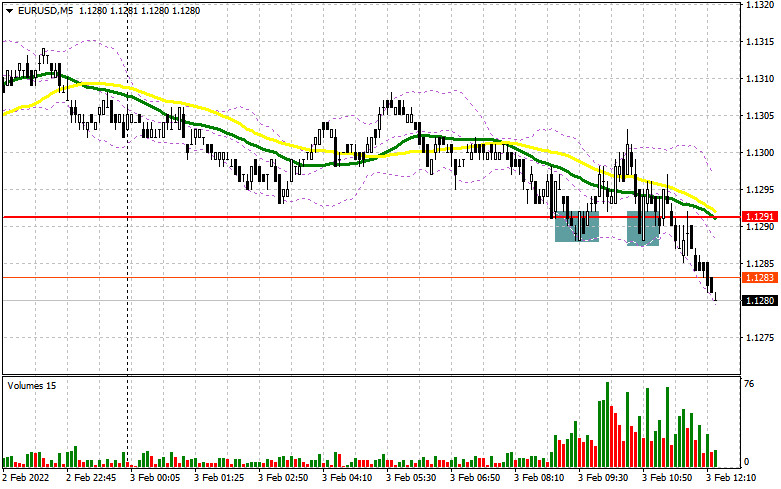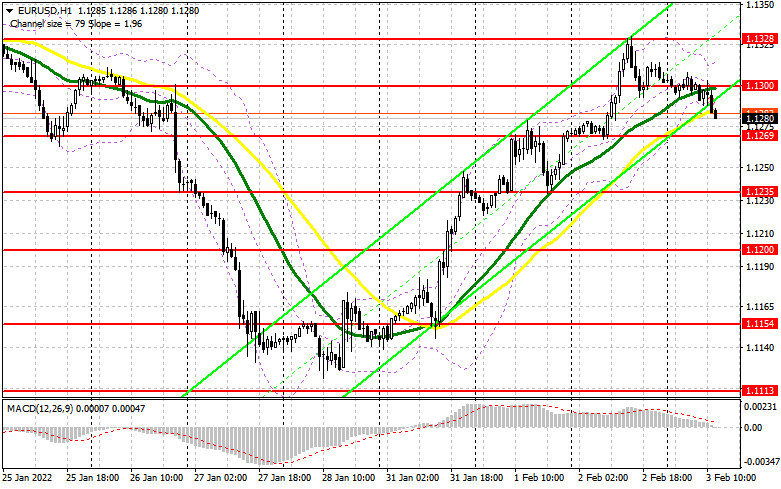
Conditions to open long positions on EUR/USD:
In the morning forecast, I focused on the level of 1.1291. Let us take a look at the five-minute chart and analyze the market situation. Early today, the euro/dollar pair was under the pressure caused by lower activity in the eurozone services sector. Bulls tried to protect the support level of 1.1291, where a perfect entry point was formed. However, the price climbed just by 10 pips. Thus, the pair broke 1.1291, thus causing a change in the trading strategy.

During the US trade, the ECB is going to disclose its meeting results. At the beginning of the year, inflationary pressure in the eurozone turned out to be significantly higher than expected. This proves that the regulator should take emergency measures. Today's decisions may have a significant influence on the market. Bulls failed to protect the level of 1.1291. That is why now they are trying to keep the support level of 1.1269. Demand for the euro may jump ahead of the ECB meeting. Notably, the eurozone PPI data did not surprise market participants and fully met the forecast. Only a false breakout of 1.1269 will provide traders with a good entry point to open long positions. Bulls should also regain control over the bottom of pattern 13, where we see moving averages, which support the bearish movement.
A breakout and downward test of the mentioned range together with hawkish accouchements that could be made by the ECB are likely to provide an additional buy signal. This, in turn, may allow the pair to return to 1.1328 and 1.1358. The level of 1.1390 will act as a farther target, where it is recommended to lock in profits. If the pair slides during the US trade and bulls fail to be active at 1.1269, the euro may again be under pressure. In this case, it is better not to open buy positions, until the price hits a low of 1.1235. Traders should open buy positions from this level after a false breakout.
Conditions to open sell positions in EUR/USD:
Sellers are not very active. The current decline in the euro was caused by bulls' failure to push the price to this week's highs. Most traders expect a more aggressive policy from the ECB. If the predictions do not come true, the euro will remain under pressure. Strong data on the US economy may allow the greenback to recoup some of its losses. Sellers should protect the resistance level of 1.1300. If the US services PMI report is strong, bulls will hardly push the price above this level. That is why a false breakout of 1.1300 may intensify pressure on the pair. This will also provide sellers with an entry point with the target at 1.1269. A breakout and a downward test of the range may give an additional short signal with the target at 1.1235. A farther target is located at 1.1200, where it is recommended to lock in profits. If the euro continues rising, it is better to avoid short positions. It is possible to open short positions after a false breakout of 1.1328.

The Commitment of Traders report for January 25 recorded an increase in long positions and a drop in short ones. Demand for risky assets is likely to remain high. Even after the publication of the Fed's meeting results, risky assets did not fall. Notably, at the meeting, the regulator hinted at the possibility of theinterest rate hikein March 2022. This week, everyone has been waiting for the results of the ECB meeting. Some traders expect that the central bank may resort to more aggressive statements. However, most analysts do not expect changes from the European regulator. A lot will depend on the ECB's decision on the bond purchasing program. If the regulator decides to stop it in March, demand for the euro may jump. The COT report indicates that long non-commercial positions rose from 211,901 to 213,408, while short non-commercial positions fell from 187,317 to 181,848. This suggests that traders continue to open long positions on the euro in the expectation of an uptrend. At the end of the week, the total non-commercial net position remained positive and amounted to 31,569 against 24,584. However, the weekly closing price decreased to 1.1323 against 1.1410 a week earlier.
Signals of indicators:
Moving Averages
Trading is conducted just below the 30- and 50-day moving averages, which indicates that the market remains under the control of sellers.
Note: The period and prices of moving averages are considered by the author on the one-hour chart that differs from the general definition of the classic daily moving averages on the daily chart.
Bollinger Bands
The upper limit of the indicator will act as resistance, if the pair continues gaining in value.
Description of indicators
Moving average (moving average, determines the current trend by smoothing volatility and noise). The period is 50. It is marked in yellow on the chart. Moving average (moving average, determines the current trend by smoothing volatility and noise). The period is 30. It is marked in green on the graph. MACD indicator (Moving Average Convergence/Divergence - convergence/divergence of moving averages). A fast EMA period is 12. A slow EMA period is 26. The SMA period is 9. Bollinger Bands (Bollinger Bands). The period is 20. Non-profit speculative traders are individual traders, hedge funds, and large institutions that use the futures market for speculative purposes and meet certain requirements. Long non-commercial positions is a total long position opened by non-commercial traders. Short non-commercial positions is a total short position opened by non-commercial traders. The total non-commercial net position is a difference between the short and long positions opened by non-commercial traders.